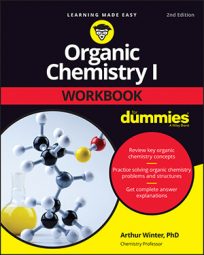When you're studying organic chemistry, keep these helpful reminders close by because they highlight some of the most important concepts you'll need to understand organic chemistry:
Electronegativity increases as you go up and to the right in the periodic table.
In reaction mechanisms, arrows show the movement of electrons; the tip of the arrow points to where the electrons are going.
Resonance is a stabilizing feature of molecules; molecular stability generally increases as the number of resonance structures increases.
Bronsted-Lowry acids are proton donors; Bronsted-Lowry bases are proton acceptors.
Strong acids have weak (stable) conjugate bases.
Conformation refers to the way a molecule folds itself in three-dimensional space based on the rotation around carbon-carbon single bonds; configuration (such as R or S configuration of a chiral center or cis or trans configuration of double bonds) refers to the specific orientation of atoms, which can change only through a chemical reaction.
Only chiral molecules have enantiomers; enantiomers rotate plane-polarized light in equal and opposite directions.
Molecules with chiral centers that have a plane of symmetry are called meso compounds; meso compounds are achiral.
In order to have diastereomers, molecules generally have to have two or more chiral centers.
Most organic reactions are driven by an electron-rich species (a nucleophile) attacking an electron-poor species (an electrophile).
Double bonds are stabilized by alkyl substituents.
Tertiary carbocations are more stable than secondary carbocations; secondary carbocations are more stable than primary carbocations. Allylic carbocations and benzylic carbocations are about as stable as secondary carbocations.
Triple bonds are shorter than double bonds; double bonds are shorter than single bonds.
Electrophiles are Lewis acids (electron acceptors); nucleophiles are Lewis bases (electron donors).
Weak bases are good leaving groups; strong bases are bad leaving groups.
Nucleophilicity generally parallels basicity. Typically, strong bases are also good nucleophiles.
Primary halides undergo SN2 substitution; tertiary halides undergo SN1 substitution.
Aromatics have 4n + 2 pi electrons; anti-aromatic compounds have 4n pi electrons.
Substituents on aromatic rings with lone pairs on the ring-attaching atom are ortho-para directors.

